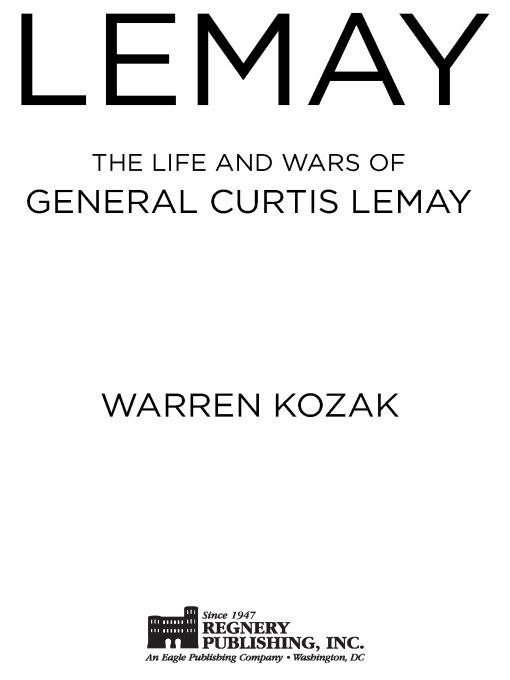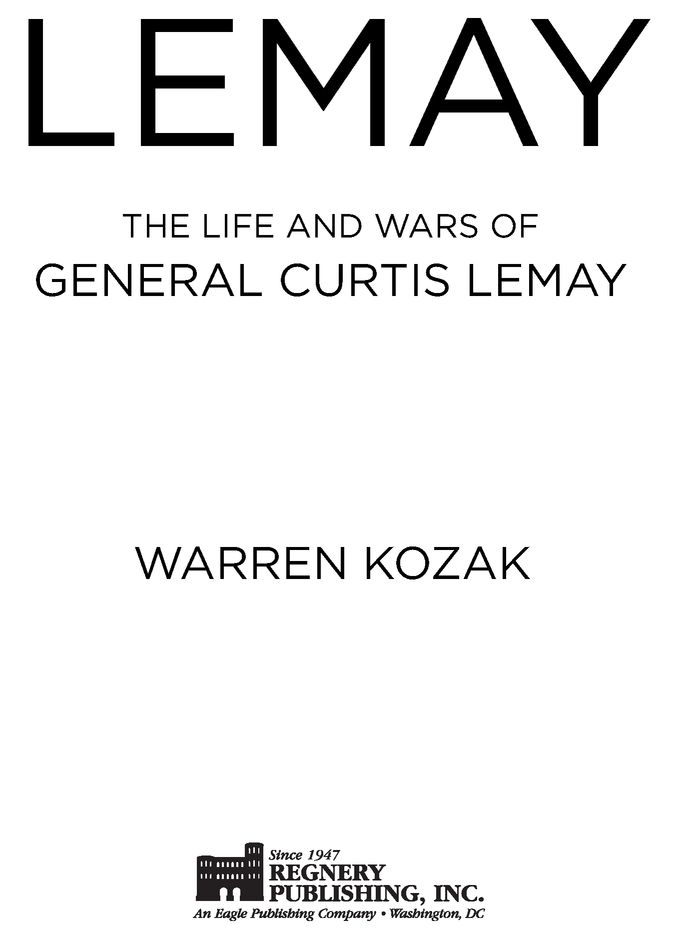Table of Contents
DEDICATION
To the brave young Americans who took to the skies to protect us all... and to my father, Sidney Kozak, who watched from below, inspired to keep moving forward.
And to Lisa and Claire.
PROLOGUE
THE FINEST MILITARY STRATEGIST THIS NATION HAS EVER PRODUCED.
ROBERT S. MCNAMARA
THE SMARTEST MAN I EVER MET.
JUDGE RALPH NUTTER
MY LEAST FAVORITE HUMAN BEING.
TED SORENSEN
HE NEVER FIT THE IMAGE OF THE AMERICAN FLYBOYDASHING, handsome, and suave. He was, instead, dark, brooding, and forbidding. He rarely smiled, he spoke even less, and when he did, his few words seemed to come out in a snarl. Women seated next to him at dinner said he could sit through the entire meal and not utter a single syllable. Surly, tactless, and with a lifeless, moist cigar constantly locked between his teeth, he was the prototype of the brutal, inhuman militarist. Most people found him frightening.
Yet somehow, Curtis Emerson LeMay, the youngest and longest-serving general in modern American history, rose from obscurity, lacking social graces, old-boy connections, or lineage, to become Americas most innovative andto this daycontroversial military commander.
In 1945, LeMay was a national hero, celebrated in victory parades and on the cover of Time magazine. Twenty years later, everything had changed. Hollywood and the press vilified him. He was parodied as the mad general in Dr. Strangelove, longing for a nuclear exchange with the Soviets. In a searing essay, independent journalist I. F. Stone labeled him the Caveman in a Jet Bomber.
Curtis LeMays career spanned an extraordinary time in America. He began flying bi-winged, open cockpit planes in the 1920s, commanded Americas postwar fleet of giant B-52 bombers, and ended his career in an age of intercontinental nuclear missiles. During World War II, LeMay helped turn the bombing effort over Europe from an ineffective and costly failure into a success. He was also the architect behind the firebombing of Tokyo and sixty-four other Japanese cities. But his enemy was not just the Germans and Japanese; he also fought complacent bureaucracy, laziness, and stupidity.
For three years, day and night, LeMay concentrated his very capable intellect on the new science of destroying property and killing people with aerial bombing. In his firebombing campaign over Japan, LeMay ordered the deaths of more civilians than any other military officer in American historywell over three-hundred thousand and perhaps as many as half a million. No one else comes closenot Ulysses S. Grant, not William T. Sherman, and not George S. Patton. Yet in the strange calculus of war, by killing so many human beings, LeMay saved millions more by making an invasion of Japan unnecessary. Most people would not want to make that kind of decisionkilling vast numbers of human beings in order to save even more. It requires someone with a ruthless sense of realismand if LeMay was anything, he was a realist.
LeMay accepted his life-and-death responsibility as just another part of his job. From a young age, he had shouldered difficult burdens. When he was eight years old, LeMay surpassed his father as the responsible figure in his family; he realized then that if he did not help feed his mother and brothers and sisters, no one else would. This experience shaped his unusually sober character, while his service in the military strengthened his sense of responsibility and duty.
LeMay was also unusually honest. He never shied away from bad news. He understood he was creating a new science and needed all the information. He would not tolerate falsifying data to cover up shortcomings. The stakes in aerial warfare were too important. But his frank nature could make him appear callous and abrupt. Ill tell you what war is about, he once told Sam Cohen, the inventor of the neutron bomb. Youve got to kill people and when you kill enough of them, they stop fighting.
Added to LeMays blunt honesty, brutal sense of realism, and strong devotion to service and country, was an odd combination of personality traits: a highly radical mind wrapped up in an extremely conservative personality. He was a mass of inconsistency. While he hated bureaucracy, he chose a career in one of the largest bureaucracies in the world. He felt at times he was too soft to lead men into combat, yet he was viewed as a very hard man by everyone else. One Congressman suggested that he be relieved of his command during the war because he seemed so unfeeling and inhuman. Yet he cared immensely about the men who served under him; he felt no responsibility more keenly than preparing them for battle.
Curtis LeMay had the unusual ability to see all parts of a battle and understand how they fit together. LeMays achievements were even more remarkable when you consider that he was working with new and highly complex machines that had never been used before, on a battlefield that was 25,000 feet above the earth.
It should be remembered that generals Robert E. Lee and Ulysses S. Grant fought seventeen battles in each of their careers. LeMay fought one almost every day for three years. And unlike any other general in modern times, he did not send his men out on perilous missions, he led them. On the most dangerous missions, LeMay insisted on flying the lead aircraft in the formation himself, in the first plane the enemy would target. His men followed him into battle. No other general in World War II did this.
LeMays involvement in momentous affairs did not end with World War IIindeed, he was a protagonist in some of the greatest foreign policy crises of the middle of the twentieth century. He was the head of the Air Force in Europe at the start of the Berlin Air Lift. In the 1950s, he created the Strategic Air Command, the massive nuclear strike force of B-52s. During the Cuban Missile Crisis in 1962 and the beginning of the Vietnam War, he represented the Air Force on the Joint Chiefs of Staff, advising the president. Finally, in the tumultuous year of 1968, he agreed to be George Wallaces running mate in the most divisive and racially charged campaign in recent times.
If a country is lucky, it will produce a Curtis LeMay in times of extreme danger. Nations need men like LeMay when survival is at stake. But once safe, these men are often rejected because they become walking reminders of events most people would rather forget. As with Curtis LeMay, sometimes these men contribute to their own downfall by continuing to display the belligerence that was necessary during battle but that does not fit in a world at relative peace.
More than sixty years and three generations after the end of World War II, it is very difficult for anyone born twenty, thirty, or forty years after the event to fully comprehend what it was really like to have the entire world at war. Rather than two or three nations fighting against each other, practically every country on the planet, every individual, and every resource was committed to the conflict. It was a war with huge ramifications for the future of mankind.
This country needed a man like Curtis LeMay in World War II and the Cold War. But a generation after the end of conflict, it is hard for many people to remember why.
CHAPTER ONE
SOMETHING STRANGE AND WONDERFUL
ON THE COLD AUTUMN MORNING OF NOVEMBER 7, 1910, FOUR-YEAR-OLD Curtis Emerson LeMay looked up from his chores, startled by a sound he had never heard before. Contrary to the law of gravity, a flying, motorized machine with a man looking back down at him was passing overhead. It came from nowhere, he wrote in his memoirs,... and I wanted to catch it.











